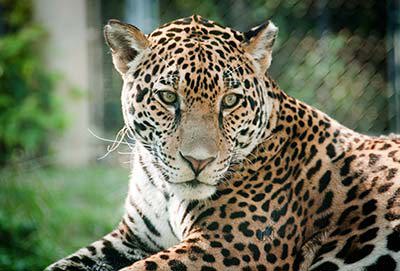Zoo New England mourns death of jaguar
Thursday March 3, 2022
 Zoo New England’s Stone Zoo is saddened to share that Chessie, a female jaguar, died on March 2.
Zoo New England’s Stone Zoo is saddened to share that Chessie, a female jaguar, died on March 2.
Chessie, age 13, had been closely monitored by her care team following the discovery of ovarian and uterine cancer last November. Prior to the diagnosis, Chessie had not exhibited any signs of health issues and was acting normally. Sadly, the cancer was already in an advanced stage and the prognosis was very poor. In recent days, Chessie’s health quickly declined and Zoo staff made the decision to humanely euthanize her for quality of life reasons.
“Chessie was an incredible ambassador for her species, and we are deeply saddened to share the news of her passing. She has been with us since her birth and will be greatly missed by all who knew her,” said John Linehan, Zoo New England President and CEO.
Zoo New England is a longtime participant in the Jaguar Species Survival Plan, which is a cooperative, inter-zoo program coordinated nationally through the Association of Zoos and Aquariums (AZA). SSPs are designed to maintain genetically diverse and demographically stable captive populations of species.
Per the SSP, Chessie, who was born at Stone Zoo on May 31, 2008, was recommended to breed with Seymour, who also resides at Stone Zoo. The pair was never successful in reproducing on their own, and due to this, the Zoo New England team worked closely with the Cincinnati Zoo & Botanical Garden’s Center for Conservation and Research of Endangered Wildlife (CREW) in the hopes that artificial insemination would prove successful for Chessie.
Last November, scientists from CREW visited Stone Zoo to work alongside the Zoo’s Animal Care and veterinary teams to collect semen from Seymour, and then proceed with the planned artificial insemination of Chessie. The procedure with Seymour was successful and several viable samples were collected. Sadly though, during Chessie’s procedure the cancer was discovered and the insemination could not be carried out.
“While this is not the outcome we desired, we are hopeful that one day the samples collected from Seymour can successfully be used to bolster the population of this iconic species,” said Linehan. “We are grateful to the CREW team for all of their guidance and expertise during these carefully planned procedures. As a conservation organization, we are deeply committed to doing everything we can to preserve and protect the incredible biodiversity on our planet.”
The jaguar is the largest cat and top predator in the western hemisphere. These animals, which are classified as “near threatened” by the International Union for Conservation of Nature (IUCN), are similar in appearance to the leopard but have a shorter tail, a broader head and a more powerful, stocky build. Rosette patterns on the jaguar’s coat, which provide excellent camouflage, are larger than the leopard’s and feature one or more central spots within the rosette. Jaguars, which are elusive and solitary, are native to South America and Central America, and range as far north as the southwestern United States.

